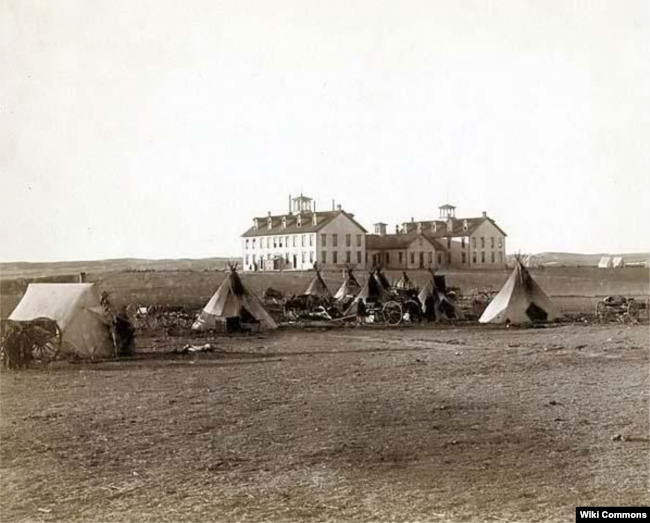The sad legacy of boarding schools
The sad legacy of boarding schools
Native American girls saying bedtime prayers at the Phoenix Indian School in Arizona, June 1900.
WASHINGTON — Ask most Native Americans about Indian boarding schools, and they will tell you that from 1879 through the late 1970s, the federal government forcibly removed thousands of Native children from their families and placed them in remote, military-style boarding schools. There, the children were abused, stripped of language and culture, and in some cases died under mysterious circumstances and were buried in unmarked graves
In announcing a federal investigation into the boarding schools, U.S. Interior Secretary Deb Haaland recently said, “The legacy of Indian boarding schools remains, manifesting itself in Indigenous communities through intergenerational trauma, cycles of violence and abuse, disappearance, premature deaths, and other undocumented bodily and mental impacts.” Haaland is the first Native American to serve in the U.S. Cabinet.
But some Native historians worry that narrative is one-dimensional.
In her book, “Boarding School Seasons,” Brenda J. Child, a citizen of the Red Lake band of Chippewa and the Northrop professor of American studies at the University of Minnesota, notes the actual history of government boarding schools differs from the historical memory of the current generation.
“History is enormously complicated, and we sometimes want easier explanations for the past,” she told VOA.
Child believes many Native Americans blame boarding schools for everything bad that ever happened to them under colonialism.
“The narrative doesn’t reflect the complexities and contradictions of the boarding school system, which was different for each generation,” she said.
Hard decisions
Amanda Takes War Bonnet, an Oglala Lakota journalist from the Pine Ridge Indian Reservation and a former managing editor of Indian Country Today, now works at the Native Women’s Society of the Great Plains, an organization dedicated to stopping violence against women.
She tells the story of her grandmother, Helen Cottier, who in September 1930 received word that her 13-year-old son Albert — Take War Bonnet’s uncle — had died after only a year away at the Indian Industrial School in Genoa, Nebraska.
“My grandmother had to travel by buckboard wagon to Merriman, Nebraska, to fetch her son’s body at the train depot,” Takes War Bonnet said. “My mother, Rebecca, was a little girl then. She wrote in her diary that she was excited that her brother was coming home. Only she didn’t know he would be coming home in a box.”
Helen’s marriage did not survive the grief of losing a child. Her husband abandoned her. Shortly afterward, she sent her surviving children to another boarding school, this time located about 70 kilometers away — a decision that might be baffling to some.
A closer look at that era in U.S. history offers insight into her decision.
Traditionally, Native Americans lived communally and could rely on one another for support during hard times. That changed after 1887 when the U.S. government carved up reservations into small allotments and parceled them out to individuals and families registered on federal rolls.
The government then sold off the remaining land — about 40.5 million hectares — mostly to non-Natives. The result was that reservations ended up in a “checkerboard” of ownership that left tribes divided and families torn apart.
In 1928, the government commissioned a study of conditions on Indian reservations. The so-called “Meriam Report” concluded that reservation Indians had not assimilated into the “dominant economic and social system” and were living in a state of extreme poverty on mostly unfarmable land.
After the stock market crash of 1929, the nation plunged into the Great Depression, and no one suffered more than the Indians of South Dakota, according to a 1935 study by the South Dakota Emergency Relief Administration. Case workers described families living in “wretched” and “demoralizing” conditions, subsisting on inadequate rations and vulnerable to tuberculosis and other infectious diseases.
In 1930, facing the prospect of rearing four children by herself, Cottier likely saw the boarding school as a place where her children were at least guaranteed food, clothing and a warm bed.
According to Child, the 1930s became the period with the highest enrollment in Indian boarding schools.
A look at the facts
The federal government, contrary to common belief, operated only 25 off-reservation boarding schools as part of its effort to assimilate Native youth into American culture. The remaining boarding schools — roughly 340 — were located on reservations and run by religious groups on land provided by the government.
Originally, attendance in government boarding schools was voluntary. Forced attendance wouldn’t come until more than a decade after the first federal boarding school — the Carlisle Indian Industrial School — was founded in 1879.
The post The sad legacy of boarding schools first appeared on Native Sun News Today.

